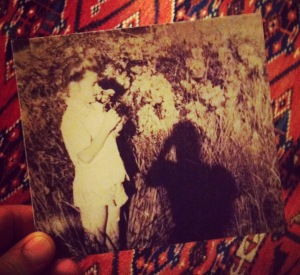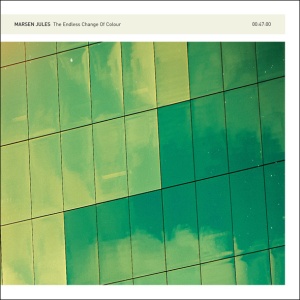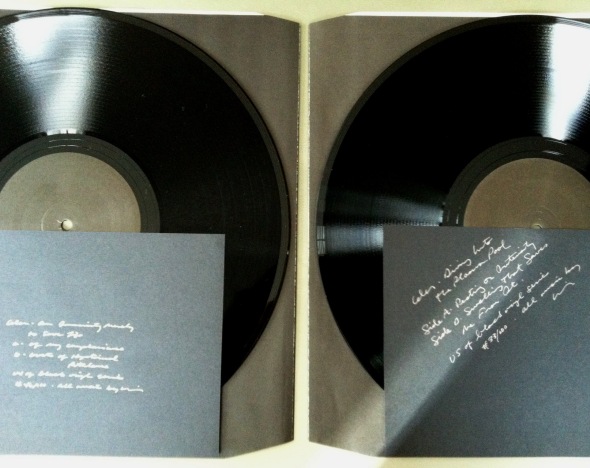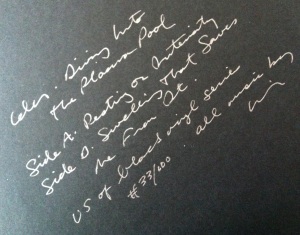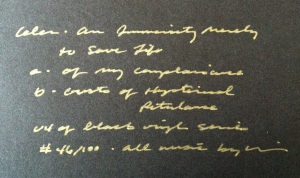Nicholas Szczepanik – Not Knowing
CD TANGENT001 Time: 52:56
Label: http://www.desirepathrecordings.com/ Artist: http://www.nszcz.com/
Auditioning long form musical works take time and with the many modern distractions it’s often difficult to dedicate an extended period to focused listening, but for Not Knowing I think you’ll want to make the time (especially if you are familiar with Nicholas Szczepanik’s previous work such as Please Stop Loving Me). In fact, if one is in the right frame of mind (like in a state of meditation, self-hypnosis or deep relaxation) the sense of time is often compressed, and one wonders ultimately where the time has gone.
This piece was originally available in a shorter version on the limited 12 part release CD3 series Ante Algo Azul from 2011, and it was a favorite of mine back then. So, I was delighted to hear that an extended version would be released by Desire Path Recordings as part of their new Tangent series.
I liken Not Knowing, which is different in form and sound from PSLM, to a dream sequence in roughly four parts, although there are threads of sound that keep the piece connected throughout. The first 12 minutes or so is a deeply pulsed and hypnotic mediation that brings one to where memories and dreams might become lucid, but still out of tangible reach. It’s at this point where an imagined orchestra appears from the ether and it flows. Is it a literal sample of another piece or is it combined with electronics? It appears like unresolved memories in a dream. I can hear chords of Elgar…wait, then Dvorak…but wait, there’s the flow of Debussy, a sleight of hand used by other composers, hiding themes from elsewhere, leaving the brain to search for a source, and the sound is ethereal and uplifting (dare I say even heavenly for the non-believers?).
Then the music and perceived vision seems to drift out of reach and almost dissolves. At the point in a dream when one loses touch, but wants to return to the visions, and then the melodies and harmonies arrive again, but in a shrouded form with layers of choral vocals. And within this new realm the piece moves into a less recognizable and deeper unknown territory before gently returning to the original sonic thread, albeit in an altered and transitional chordal-tone state and ultimately the arrival back into the warmth of the visceral pulses.
Although quite different in presentation and instrumentation, I compare the journey in this album to that of some other favorites of mine like Vangelis Papathanasiou’s Rêve from the album Opéra Sauvage and Tangerine Dream’s Desert Dream from their double live album Encore. The development and sound architecture of the piece is clearly influenced by the works of French electronic composer Éliane Radigue, to whom Szczepanik dedicates the album.
Marsen Jules – The Endless Change Of Colour
12k Label – 12k1074 – CD Time: 47:00
Website: http://www.12k.com/index.php/site/releases/the_endless_change_of_colour/
When I was younger and had a completely untrained eye for seeing, as in art of any form, I didn’t realize how many colors went into what I saw, whether in a landscape or an object (same in the musical parallels). It was later, seeing artwork at a museum (paintings up-close), dramatically enlarged photos, and a friend’s work in college (artist, Allen Hirsch) that I started to understand the density and complexity of color–as well as in sound and music, the overtones, harmonics and phasing in addition to the pure waves.
The Endless Change Of Colour affects me in two ways, creating a state of peaceful timelessness (wondering where that nearly-an-hour went) as well as producing a state of nearly motionless cascades of blending sounds that transmute into a sense of relaxing in a stream bed of flowing water on a warm summer’s day–when all else falls away and what remains is that moment. All of this from a generative piece of music built from a single phrase on an old jazz record split into three audio stems. The sounds (and side-effects) that without closer examination and contemplation, we wouldn’t normally sense except for the benefit of the time that this work seems to warp and retrograde during its existence.
There are brief moments when almost familiar sounds enter, only to be absorbed back into the metamorphosing blend. I hear some parallels to the effects created by Nicholas Szczepanik’s brilliant album Please Stop Loving Me, although the feeling in Endless borders on that of a gentle voice on the edge of a dream–a peaceful sense of belonging.
Celer – Black Vinyl Series – Parts 4 and 5
Diving Into The Plasma Pool – Part 5 Black Vinyl Series
Side A: Resting On Intensity 20:33 Side B: Swelling That Saves Me From It 20:10
An Immensity Merely To Save Life – Part 4 Black Vinyl Series
Side A: Of My Complaisance 18:27 Side B: Gusts of Hysterical Petulance 19:05
Self-released Limited Edition of 100 copies on black vinyl with matte black paper sleeve with handwritten credits
Celer’s Websites: http://thesingularwe.org/celer/ & http://celer.bandcamp.com/music
Insert for Diving Into The Plasma Pool
I almost missed them entirely, but something appeared on my screen in late January, and within 5 minutes I was transported to a perfect sunny day, in the middle of a gently rolling sea, on a reach in a sailboat, and to a sonic warmth that dissolved the doldrums of my winter reality. It was Diving Into The Plasma Pool, the latest (and I think last) of the five part Black Vinyl Series by Celer (Will Long). For whatever reason, I missed parts 1 through 3, but as soon as I heard a sample from Resting On Intensity (Side A), I looked to see if there were other LPs still offered—and indeed, Part 4 was (and is) still available. Part 4, An Immensity Merely To Save Life starts a bit darker with Of My Complaisance (Side A) and then softens with Gusts of Hysterical Petulance (Side B).
Insert for An Immensity Merely To Save Life
The subtle enmeshed loops of Diving Into The Plasma Pool flow like Debussy’s Nuages and yearn (although more gently) like Nicholas Szczepanik’s Please Stop Loving Me—they are waves that crest, hold onto a pleasurable edge and then dissolve. The chords and sounds are right in my sweet-spot. But enough from me; just listen—better yet, buy one or both of them. They’re gorgeous, full and resonant—simply magical.
Part 5 (available here): http://celer.bandcamp.com/album/diving-into-the-plasma-pool
Part 4 (available here): http://celer.bandcamp.com/album/an-immensity-merely-to-save-life
Review: Every Hidden Color – Luz
Label: Streamline #1033 12” Vinyl LP (no digital download) – Tracks: I – 17: 04 & II – 18:00
Album available from NSZCZ: http://www.nszcz.com/a-few-copies-of-luz-are-for-sale/
Nicholas Szczepanik http://www.nszcz.com/ http://soundcloud.com/nszcz
Federico Durand http://www.federicodurand.blogspot.com/ http://soundcloud.com/federicodurand
More information on album and available at http://www.dragcity.com/artists/every-hidden-color
Every Hidden Color is a collaboration of two hemispheres and opposing seasons: Nicholas Szczepanik in North America (Chicago) and Federico Durand in South America (Buenos Aires). The work of these two artists to date is, to my ears, quite different, and the results in Luz are intriguingly harmonious.
Szczepanik’s work tends to be more serious and deliberate, and at times quite dense with broad masses of sound. Of his most recent work, my strongest connection, is to his album Please Stop Loving Me, which is indescribably beautiful and yearning in its meshing of sound and emotion. I am less familiar with Federico Durand’s work, but I have heard portions of his albums La Siesta del Ciprés (The Nap of the Cypress on the Spekk label) and the more recent (and bad luck for me it’s sold out!) album El Extasis de las Flores Pequeñas (The Ecstasy of Small Flowers on the Own Records label). Durand’s work tends more towards the introspective and ethereal, deftly woven with field recordings.
The pulsing of cicadas, crickets and a streetscape is how Luz opens before drifting into gentle winds (or is it the noise of a distant highway…or does it really matter?) and then a rhythmically swaying melody appearing like a soothing mantra, to then disappear into a sparsely layered and introspective suspension of reality. From there, come gentle rains, soft guitars, birds in the nearby trees, and then all drifts into the softest of walls of sound and finally gentle voices.
This is an album of contemplation and a sensitive appreciation of the world around us, from the smallest sound to the broadest landscape, and also to the light—Luz.
Celer Machinefabriek – Maastunnel/Mt. Mitake – Numa/Penarie – Hei/Sou *UPDATED sound links*
Artist website: http://www.machinefabriek.nu
Artist website: http://www.thesingularwe.org/celer/
Available at: http://machinefabriek.bandcamp.com/ and http://www.experimedia.net/
Videos by Marco Douma: http://www.marcodouma.com/
“Having a great time, wish you were here…”
While some on holiday are sucked into over-crowded commercial tourist traps, and others are off in their resorts or private villas, some of the most memorable places and experiences are the somewhat unusual, even off the beaten-path locales. Picture postcards often contain brief accounts or memories of travels to these places, being descriptive, cryptic or comical anecdotes of a given day’s events, compressed into a few short phrases—a substitute for longhand letters. They also serve to freeze a moment in time in a more permanent and retrospective fashion than the immediacy of a quick e-mail or photo sent via the internet. These moments in time are what the trilogy of releases by Celer (Will Long) and Machinefabriek (Rutger Zuydervelt) are like.
It started when they performed together in November, 2010 in Tokyo, Japan and then decided to collaborate remotely on a series of short releases beginning in October, 2011 between Tokyo and Rotterdam. The pieces started as larger works and eventually were edited into musical postcards, or drone poems* of sorts, evoking a place, event or state of mind. Artwork found by Long in Tokyo has been used for the covers of the 7 inch vinyl releases with design and graphic layout by Zuydervelt. As much as I appreciate the convenience of digital-format music, there is something quite special about the 7 inch record, packaged in artful sleeves of re-purposed postcard and souvenir images. Even better, each piece is accompanied (via download) by a beautiful and timeless video interpretation by multimedia artist Marco Douma.
The soon-to-be-released Hei/Sou is the last in this trilogy. Maastunnel/Mt. Mitake and Numa/Penarie were the first two releases. Digital files are also available and the vinyl pressings are limited to 250 copies each (Maastunnel/Mt. Mitake vinyl is now sold out).
Maastunnel/Mt. Mitake are readily identifiable places. Maastunnel is a tunnel in Rotterdam and this track has some mystery. The piece opens on the outside approach to the tunnel (with the ambient sounds of water). There is an apparent twist in the plot where voices can be heard, “I didn’t see his face…he might have been just anybody…just anybody.” Suddenly, a break to the interior where vehicles are passing over expansion joints creating pulses that resonate throughout the underground structure before a quick return to the roadway above-ground. Mt. Mitake is a contrast to the underworld. It starts with a sense of floating in the clouds. The second section creates a sense of tension with the calming effects of the first section in the background; kind of a panoramic view with scenes changing. The peaceful opening section returns to close the track.
Numa/Penarie are more obscure experiences. Numa is almost like a collection of sounds experienced throughout the day; clusters of lights buzzing, bell-like sounds, subways braking, jets taking off in the distance. The second section is more intense (again, a feeling of being underground), expansive and layered with lower frequencies underneath. The close brings a return of lighter and higher frequencies, returning somewhat to the opening themes. Penarie is perplexing; it’s dense, electric and unrestrained. It expands and contracts with clusters of tones. Then there is a pleasant interlude of Mellotron-like waves before mixing with the original themes and sounds, while being accompanied by a clock and then fading quickly, almost like a fleeting dream.
The forthcoming Hei/Sou is the more contemplative of the three releases, and the most abstract. Hei starts with a cymbal-like percussive and then drifts into a gentle sustained keyboard mantra with a wandering background of gentle buzzing and contrasting deep bell-like tones. The cymbals return and are combined with a placid cluster of sound. Sou opens with a Morse-code-like pulse and omnipresent warping tones that gradually combine with a fabric of lightly sequenced rhythms, and there they hang in suspension as the pulsing grows stronger and then fades. Gradually an undertow of deep liquid sound emerges to the foreground and the rhythms are overtaken and then disappear.
These self-released sound postcards are beautifully presented visions of places and experiences. Where will Celer and Machinefabriek be traveling to next?
Maastunnel/Mt. Mitake Preview
Numa/Penarie Preview
Hei/Sou Preview
***
*Drone Poem: Like Tone Poems, a shorter format single musical work, within the drone or electro-acoustic genre, based on or evoking the content of a poem, story, place or event. The term initially inspired by some of the recent shorter-form works by Nicholas Szczepanik on his album We Make Life Sad.
***
A solicited review, but I have purchased the first two releases and now preordered the latest.
In Rotation
Various albums are in rotation here at the moment, with some “classical” recordings (Bernard Herrmann, Aaron Copland and a Karajan rehearsal) on the way from an auction I recently bid on at Polyphony:
http://www.polyphonyrecordings.com/
Printed and online catalogs become available (every two or three months) and Lawrence Jones (the proprietor of Polyphony) conducts auctions as he has since 1978 (reel-to-reel tapes, LPs, books and other items). The recordings are each graded for condition (as well as the covers) and auditioned by Larry, so one can rest assured that they arrive as described and carefully packaged. Larry has many rare items and often entire recording collections become available, like a recent, almost complete collection of Camden label LPs, here:
http://www.polyphonyrecordings.com/camden_gallery.php
******
Before anyone thinks I’m listening only to ambient music these days, here’s a brief overview of things moving between turntables and CD players:
Medeski Scofield Martin & Wood – In Case The World Changes Its Mind (Live) – fabulous recording!
Van Der Graaf Generator – A Grounding In Numbers – It’s surprisingly good…and gritty.
Drums Between The Bells – Brian Eno and Rick Holland – The piece “Glitch” is remarkable, among others.
Nicholas Szczepanik – Ante Algo Azul – A twelve part suite of recordings along with artwork, custom sleeves and poetry that I am delving into now, fascinating.
Steve Wilson – Grace For Drowning – Excellent
Carolina Chocolate Drops – Luminescent Orchestrii (10″ 4 song vinyl EP)
Elizabeth Fraser – Moses (12″ vinyl EP) – I miss her voice from the days of Cocteau Twins
James Blake – his first eponymous double vinyl LP–really interesting and a (dynamically) challenging recording of great depth. With thanks to my son for getting this for me.
The Black Keys – El Camino – kicking some rock and roll and blues butt.
Yellow Birds – The Color
Fountains of Wayne – Sky Full of Holes – More finely crafted songs.
Tom Waits – Bad As Me – This album just rips.
Wire – Chairs Missing (revisiting a great album from 1978)
Montt Mardie – Skaizerkite – Really energetic songs (AKA David Olof Peter Pagmar) from Sweden.
The Bruford Tapes – From 1979, a reissued 2 channel FM broadcast by Bill Bruford and band.
Long Way Down – Soundtrack to the African motorcycle adventure taken by Ewan McGregor & Charley Boorman.
Leonard Cohen – Old Ideas – His 12th studio album…I’ve only heard excerpts and so far and I’m looking forward to this.
Michael Franks – Time Together (released in the summer of 2011) – some great songs from the humorous “Mice” to the heartfelt farewell to his family’s pup, Flora. Gil Goldstein’s arrangements on this are absolutely magical.
Trombone Shorty – For True – Get your funk on!
Taylor Deupree – his albums Shoals and Northern (on his 12K label), electronic/acoustic explorations, beautifully packaged.
Tomas Phillips + Mari Hiko – Prosa (on M. Ostermeier’s Tench label) – Dynamic recording and imagery.
John Zorn – The Gates of Paradise – inspired by the works of William Blake with John Medeski, Kenny Wollesen, Trevor Dunn and Joey Baron – A really beautiful, lyrical and mysterious work inspired by the mystic.
Martin Schulte (Marat Shibaev) – Silent Stars, Odysseia and Treasure – Atmospheric Techno
bvdub – Then – House, Techno, experimental and ambient
There just isn’t enough time in the day (nor money in the music budget). Anyone else have suggestions?
My Online Reviews Currently Appear At…
http://affordableaudio.org/Affordable$$Audio/Current_Issue.html and http://www.hifizine.com/ Stay tuned for additional online locations.
On Instrumental Music – Old and New
Teaser: I’m working on a review of “Winter Garden”, the new instrumental CD by Eraldo Bernocchi, Harold Budd and Robin Guthrie on the RareNoiseRecords label.
****
In a recent broadcast of the American Public Media program “On Being”, Krista Tippett was talking with the late Irish poet and philosopher John O’Donohue who noted, “Music is what language would love to be if it could.” It’s a fascinating interview on what O’Donohue explored throughout his short life (he died at the age of 52 in 2008) and called “the invisible world” and ties to spirituality, mysticism, beauty, and ties to his Irish homeland and history.
http://being.publicradio.org/programs/2012/inner-landscape-of-beauty/transcript.shtml
While I don’t necessarily think written or spoken language is inferior to music, instrumental works can evoke instantaneous memories or emotions that are often indescribable. Certainly, spoken words or sung lyrics can elevate, or make more familiar, the emotion of a piece, but I have always been fascinated by instrumental music, from early to modern as well as current forms (either as pure electronic or combined acoustic, found-sampled sound coupled with electronic music).
I often return to familiar musicians for new work and to revisit their earlier works. Many long-established artists continue to explore and reinvent themselves. Brian Eno and his many collaborators is an example of such an artist. With the demise of so many traditional record shops (especially in rural and suburban areas), I have found it increasingly difficult to find new music. Time was when I could walk into my local record shop and “Bob” who I had known for years knew my tastes in music, but also knew I was open for new explorations. If I was on the hunt for something new, “Bob” always had great ideas, but now he’s gone.
It has taken me some time, but slowly, I am finding new sources for music (in addition to word-of-mouth from friends), whether it’s direct from independent music labels, music related websites, podcasts or referrals from musicians. I have also found the (almost instant) crowd-sourcing aspect of Twitter to be very helpful for finding legal sources for artist’s works when some outlets are out of stock.
Music comes from unlikely sources too. Recently I was listening to an NPR Heavy Metal (not my usual haunt) genre podcast from NPR’s All Songs Considered, and NPR Music’s Lars Gotrich paused between Metal songs to refer to a young electronic/drone musician from the Chicago area named, Nicholas Szczepanik. The piece that Lars sampled was a short excerpt from NS’s mid-2011 release “Please Stop Loving Me”, a single 48 minute track, a portion of which is here:
Certainly, some people will react differently, but my reaction to “PSLM” was instantaneous and visceral. The layering of the sound, the reaching for something and when almost at the point of contact the music shifts slightly to another layered emotion, feeling or color. Yet, I found the piece incredibly relaxing and comforting despite its density. It took me a few tries to find a CD of the work, but thanks to that instant crowd-sourcing at Twitter, I found a copy in France from: http://www.bassesfrequences.org/ Jerome, the owner of the website, could not have gotten me the CD much faster. “PSLM” is a really remarkable work. I look forward to Nicholas’s forthcoming releases.
Nicholas has two LP releases coming soon (that’s right folks, vinyl) : “The Truth of Transience” available at: http://www.isounderscore.com/ and “We Make Life Sad”, soon to be available at: http://www.mewelesite.be/ (and it looks like the LP will be pressed with clear vinyl).

